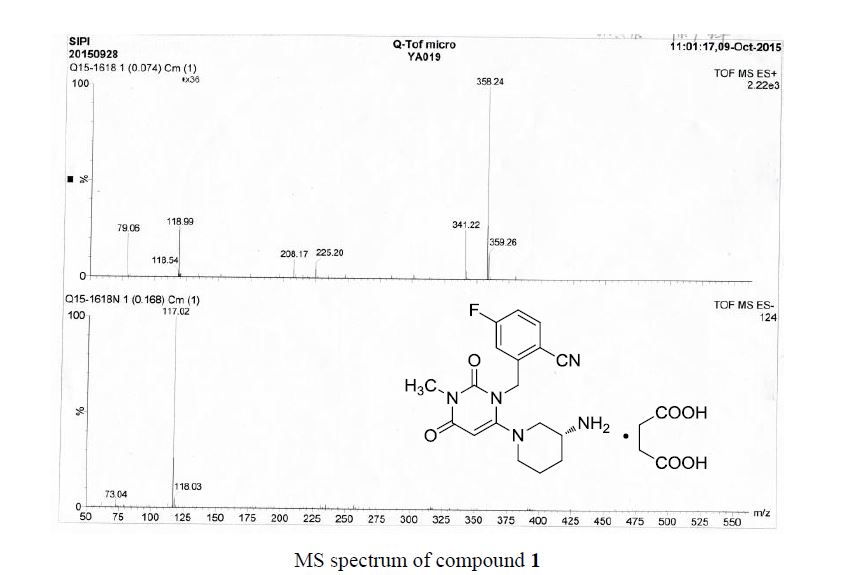

Trelagliptin succinate, a novel once-weekly oral dipeptidyl peptidase-4 (DPP-4) inhibitor, was approved for the Japanese market on March 26, 2015
Trelagliptin exhibited a better potency against human DPP-4 than alogliptin and sitagliptin, along with its excellent selectivity and slow-binding properties that may partially contribute to its sustained efficacy. In phase III clinical studies, once-weekly oral trelagliptin provided long-term safety and efficacy in both monotherapy and combination with other antidiabetic medicines and was proved to be noninferior to its analogue alogliptin used once daily.
2-({6-[(3R)-3-Aminopiperidin-1-yl]-3-methyl-2,4-dioxo-3,4-dihydropyrimidin-1(2H)-yl}methyl)-4-fluorobenzonitrile Monosuccinate (1)
white solid
Mp: 186–188 °C (187.1 °C in literature
(x)),
[α]
D20 = 16.4 (c 1, DMSO, 16.7 in literature
(x)),
1H NMR (400 MHz, CD3OD) δ (ppm):7.79–7.82 (m, 1H), 7.15–7.25 (m, 2H), 5.46 (s, 1H), 5.20–5.32 (m, 2H), 3.35–3.37 (m, 2H), 3.22 (s, 3H), 3.03–3.06 (m, 1H), 2.74–2.81 (m, 2H), 2.49 (s, 4H), 2.07–2.11 (m, 1H), 1.82–1.89 (m, 1H), 1.65–1.76 (m, 1H), 1.55–1.59 (m, 1H).
MS (ESI+): m/z, 358.24 ([M + H]+).
Anal. (C22H26FN5O6) calcd: C, 55.57; H, 5.51; N, 14.73; found: C, 55.32; H, 5.46; N, 14.62.
State Key Lab of New Drug & Pharmaceutical Process, Shanghai Key Lab of Anti-Infectives, Shanghai Institute of Pharmaceutical Industry, State Institute of Pharmaceutical Industry, Shanghai 201203, China
An improved process for the synthesis of antidiabetic drug trelagliptin succinate through unprotected (R)-3-aminopiperidine was described. The impurity profile with different conditions of the key substitution was illustrated, and then the best reaction condition was identified. The optimizations also included the bromination of 4-fluoro-2-methylbenzonitrile so that the process became efficient and concise.
- 1.
Zhang, Z.; Wallace, M. B.; Feng, J.; Stafford, J. A.; Skene, R. J.; Shi, L.; Lee, B.; Aertgeerts, K.; Jennings, A.; Xu, R.; Kassel, D. B.; Kaldor, S. W.; Navre, M.; Webb, D. R.; Gwaltney, S. L. J. Med. Chem. 2011, 54, 510– 524, DOI: 10.1021/jm101016w
- 2.
Feng, J.; Gwaltney, S. L.; Dipeptidyl Peptidase Inhibitors. PCT Int. Appl. WO 2005095381, October 13, 2005.
- 3.
Grimshaw, C. E.; Jennings, A.; Kamran, R.; Ueno, H.; Nishigaki, N.; Kosaka, T.; Tani, A.; Sano, H.; Kinugawa, Y.; Koumura, E.; Shi, L.; Takeuchi, K. PLoS One 2016, 11, e0157509, DOI: 10.1371/journal.pone.0157509
4.
Once-weekly trelagliptin versus daily alogliptin in Japanese patients with type 2 diabetes: a randomised, double-blind, phase 3, non-inferiority study
Inagaki, Nobuya; Onouchi, Hitoshi; Maezawa, Hideaki; Kuroda, Shingo; Kaku, Kohei
Lancet Diabetes & Endocrinology (2015), 3 (3), 191-197 CODEN: LDEAAS; ISSN:2213-8587. (Elsevier Ltd.)
Trelagliptin is a novel once-weekly oral DPP-4 inhibitor. We assessed the efficacy and safety of trelagliptin vs. the daily oral DPP-4 inhibitor alogliptin in Japanese patients with type 2 diabetes. We did a randomised, double-blind, active-controlled, parallel-group, phase 3, non-inferiority study at 26 sites in Japan.
We included individuals with type 2 diabetes inadequately controlled by diet and exercise. We randomly assigned patients (2:2:1) to receive trelagliptin (100 mg) once per wk, alogliptin (25 mg) once per day, or placebo for 24 wk. Randomisation was done electronically and independently from the study with permuted blocks of ten patients. Patients and clinicians were masked to group assignment.
Patients in the trelagliptin group were given trelagliptin once a week and oral alogliptin placebo every day, whereas patients in the alogliptin group were given oral trelagliptin placebo once a week and oral alogliptin every day (double-dummy design). Patients in the placebo group were given an oral alogliptin placebo once a day and an oral trelagliptin placebo once a week. Our primary outcome was between-groups difference in change in HbA1c concn. from baseline to the end of treatment. The non-inferiority margin was 0·4%. Our anal. included all patients who were randomised and received at least one dose of study drug. The study is registered with ClinicalTrials.gov, no. NCT01632007.
Between May 26, 2012, and Nov 20, 2012, we enrolled 357 patients. 243 patients were included in the anal. (101 for trelagliptin, 92 for alogliptin, and 50 for placebo). In the primary anal., the least squares mean change in HbA1c concn. was -0·33% in the trelagliptin group (SE 0·059) and -0·45% in the alogliptin group (0·061) based on the ANCOVA model. The least squares mean difference (trelagliptin minus alogliptin) of change from baseline in HbA1c concn. was 0·11% (95% CI -0·054 to 0·281). Trelagliptin was non-inferior to alogliptin. Both active groups had significantly reduced mean HbA1c concns. at end of treatment compared with placebo (p<0·0001). The frequency of adverse events was similar between groups. No hypoglycemia was reported with trelagliptin and the drug was well tolerated.
The once-weekly DPP-4 inhibitor trelagliptin showed similar efficacy and safety to alogliptin once daily in Japanese patients with type 2 diabetes. Trelagliptin could be a useful new antidiabetes drug that needs to be given once a week.Takeda Pharmaceutical Company.
- 4.
Inagaki, N.; Onouchi, H.; Maezawa, H.; Kuroda, S.; Kaku, K. Lancet Diabetes Endocrinol. 2015, 3, 191– 197, DOI: 10.1016/S2213-8587(14)70251-7
- 5.
Inagaki, N.; Sano, H.; Seki, Y.; Kuroda, S.; Kaku, K. J.Diabetes Investig. 2016, 7, 718– 726, DOI: 10.1111/jdi.12499
6.
Feng, J.; Gwaltney, S. L.; Dipeptidyl Peptidase Inhibitors. PCT Int. Appl. WO 2007035629, March 29, 2007.
//////////


















